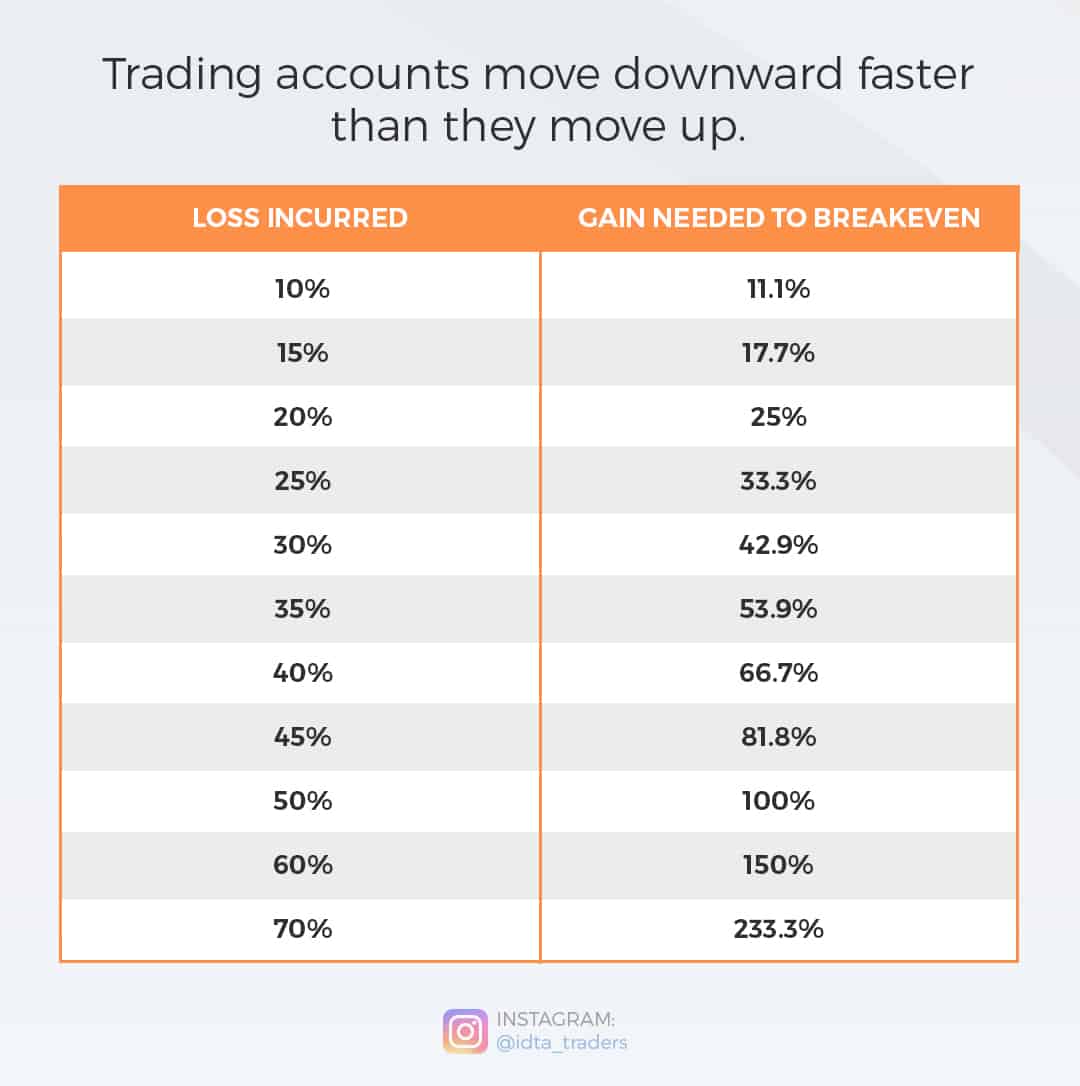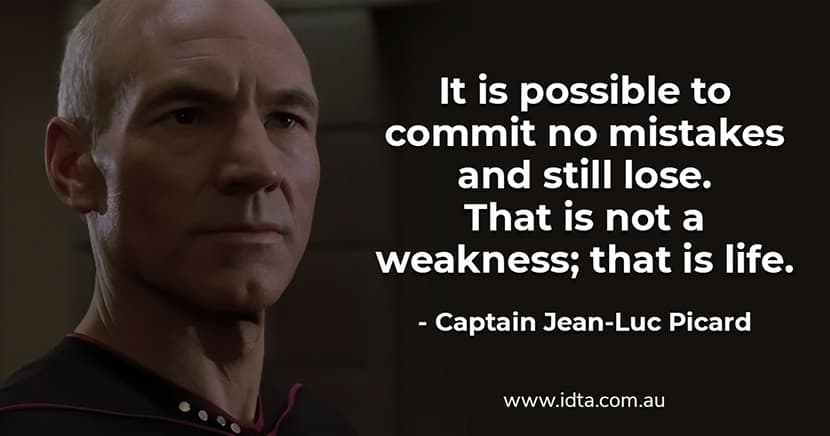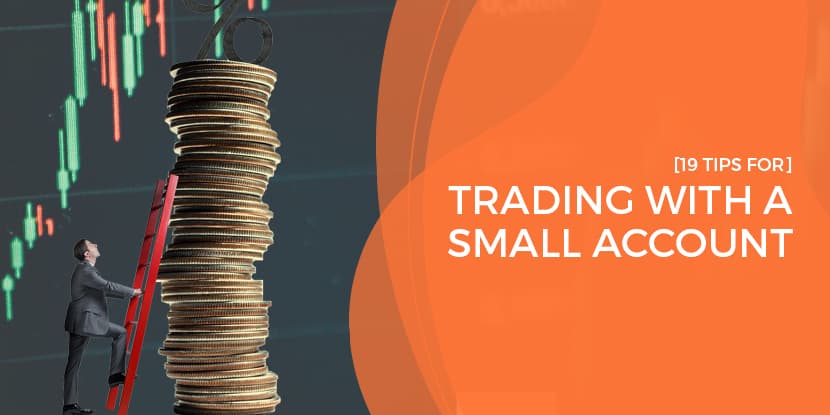Growing a small trading account is difficult for those who aren’t patient. If you can follow the steps outlined in this article, you’ll learn to slowly build creating opportunities to make bigger profits down the road.
When you’re trading with a small account you have fewer luxuries than that of a trader with a larger account. You have a much smaller pool of funds to protect. You need to patiently and methodically build your account, allowing it to compound over time.
I’ve had many traders ask me over the years how to grow a small trading account. So, I’ve put this article together to help answer that question.
How To Trade a Small Account
Although trading a small account can seem daunting, there are a few things you can do in order to make the process easier.
Here are 19 tips for trading with a small account:
1. Know What You’re Doing
Sounds obvious, possibly even condescending, though that’s not my intention. The fact is that so many new traders try to learn by doing before they know the basics.
Learning by doing, trading real money, often ends in disaster. Make sure you fully understand the basics before you start trading, otherwise you’ll only compound your losses. This is especially true for anyone trading with a small account.
The best way to learn to trade is to consider day trading courses for beginners through an online trading academy.
When looking at learning to trade, consider an educator with a transparent strategy, and a strong focus on support. You can certainly learn via an online course, just make sure there is also a day trading mentoring program or other support provided.
Once you know how to go about trading you will be better able to protect the funds in your small trading account.
2. Set Realistic Goals
Don’t set unrealistic goals, or you’ll end up frustrated and quit. Instead, set realistic goals that you can actually achieve.
You’re trading with a small account; you can’t reasonably expect to make $500 a day straight off the bat. If you set goals that are too ambitious, you will end up risking more of your account than you should be.
Decide on modest goals to begin with, something that you can build on top of as your account grows. Be sure to write your goals down, and track your progress to help ensure that you reach those goals.
The aim of the game is to “go slow to go fast”. The more your account moves backwards, the better you need to perform to build it back again. The table below shows just how much you need to make back in order to break even from a loss.

3. Don’t Over Risk
Make sure you’re not over risking your trading account. If you are trading with a small account, you need to be very careful with each and every trade. Over risk and you could lose all of your profits, and even more if you have margin debts.
A good rule of thumb is to risk – at most – between 1% and 2% of your trading account per trade, or per day.
This is where greed crushes many new traders. It’s tempting to try a short cut and place big trades in order to grow an account. What almost always seems to happen is that the trader blows up their account and loses all their money.
Trading is a game of accumulation, if your risk is based on a percentage of your account size, then compounding will dictate how quickly your account grows (or shrinks). I like to consider my trading as a business, so I don’t make any risks that I wouldn’t in a traditional business.
4. Use a Stop Loss Order
A stop loss order is a great way to protect your profits and more importantly, limit your losses. When you place a stop loss order, the broker will automatically exit your trade when price reaches the level where you placed your stop loss.
I’ll talk about technical analysis a little later, but this is how you would gauge where to put the stop loss. Your analysis will be able to tell you the point at which a trade isn’t likely to be profitable.
Rather than hold on and potentially lose much more money, your stop loss will limit the damage.
A lot of traders don’t realise it, but a stop loss can also help you maximise your profits. You can do this using what is called a “trailing stop”. The idea is to move your stop loss up progressively as you move further and further into profit.
This maximises profit because it removes the chance of price reversing and wiping out your profits. Once way to use a trailing stop is to move it to break even when you’re able, thus taking a loss out of the equation. Then progressively follow price leaving enough room to balance between being stopped out and allowing the most profit.
A stop loss should be considered a safety net which every trader must use. Similar to a tight rope walker where a safety net prevents a fall all the way to the ground. The safety net limits the damage; same with trading.
When you’re learning how to grow a small trading account, this is very important.
5. Trade With A Profit Target / Take Profit
When trading with a small account it’s important to remember to use a profit target.
Similar to a stop loss a profit target will automatically exit you from the trade. The difference is that this price is used to exit the trade with the available profit expected based on your analysis.
A take profit is useful in that it allows you to limit the feelings of greed when trading. Before you enter the trade you already know where you want to get out.
Setting the take profit before you even enter the trade will allow you to let your trade run.
6. Don’t Over Trade
Over trading is one of the major causes of losses for anyone trading a small account. Trading too much puts you at risk of losing all your profits, and even more if you have margin debts. Make sure to stick to a risk – at most – per trade or per day limit.
The more you trade, the more risk you have in the market. If you’re “on a hot streak” you might trade once too often and give back all your profits. If you’ve had a few losses you may “revenge trade” looking to claw back some of the losses, but instead, dig a bigger hole.
You also need to consider commissions; if you’re trading a small account, and each trade has commission, you eat up funds quick.
Have a set number of trades that are considered to be the maximum number per day and stick to fewer than or equal to that.
7. Be Patient
Don’t expect to make big profits overnight. It can take a few months to see real progress. Remember, you’re trading a small account. Unless you are over-risking you funds, you’re unlikely to see massive gains. Trading is not about getting rich quick, it’s a business that you look to build up with exponential growth.
Many new traders trading with a small account are prone to trading with too much of their capital at once, or trading too often. In the pursuit of fast gains, what actually happens is the account goes backwards (often fast).
If you trade based on a percentage of funds you hold, the dollar amount at risk grows without growth in the % risk. As the account grows, you can maintain a level of risk while still providing exponential growth. This is assuming you are able to be consistently profitable.
8. Stick to a Plan
When it comes to how to grow a small trading account, success often comes down to following a plan. Without a plan, you’re pretty much flying by the seat of your pants and that’s not going to work very well.
You trading plan dictates your objectives along with the methods you will use to achieve those objectives.
Imagine you’re headed somewhere that you’ve never been before. If you don’t have a map, how do you know which road to take? When do you exit that road? How safe is the road you’re taking? This is what your trading plan will provide.
When you’re trading with a small account, your trading plan will let you know when to enter and exit trades, what to trade and when, how much you risk, etc. Stick to the plan to provide yourself the best chance of achieving your trading goals.
Learn how to write a trading plan, or download a trading plan template.
9. Gain Live Trading Experience (In Simulation)
No matter what you learn, how much theory you are able to understand, you always learn more by doing.
Once you have a trading plan that outlines how to find trades and how to manage open trades, you need to practice execution.
When it comes time to practice your trading you should always do so on a simulated trading account. This type of account holds fictional funds, so you’re not risking real money.
This will help you not only practice entering and exiting trades based on your strategy and plan; but also, how to use the trading platform itself.
There are 2 things that you need to achieve before you switch from sim to live trading with real money. First you need to create a mindset where you treat the fictional funds as real, and trade how you would if the money were real. The second and more important thing is to prove consistency in your trading.
I like to suggest setting a goal that acts as an indicator of whether you’re ready. This might be to double the size of the account, or have a certain win/loss rate, something tangible.
Day Trading a live account is a bit like driving a car. When you’re very new there are emotions of fear or nervousness. The reason you have to practice your driving before you can drive by yourself is so that you become comfortable and confident in your abilities. Once you’ve proven yourself, and you’re a confident driver you get your full license.
It’s the same with trading a simulated account. You need to build your competence and confidence so that your decisions are as logical and emotionless as can be.
Continuing the metaphor of learning to drive; this is exactly why we run live day trading rooms. These are rooms where professional traders identify trades to guide you as you learn.
While trading a simulated account, do your best to trade exactly how you would if the money were real. The transition will be simpler and you’ll be able to start off on the right foot.

10. Use Performance Tracking Documents / Software
Use tracking software to help you stay on top of your trading results. This will help you see whether your goals are being met, and give you a better understanding of your trading strategy.
The best tool for trading performance while trading a small account is a trading journal. This is where you will log the outcomes of your trades and also summarise your session. A trading journal will allow you to track both your statistical performance and your emotional journey.
Using a trading journal, you will be able to understand what’s working in your trading, and what isn’t. With this information you can optimise your strategy, or focus on areas where you perform best.
You can use purpose-built software for creating your trading journal, or you can simply use excel to track this information. You can get a free trading journal template here.
11. Stay Positive
If you’re trading a small account, you need to stay positive. A negative mindset is the killer of many new traders trading journeys. The thing that you need to remember is that nobody starts out consistently profitable in their trading. Trading is a performance sport, with more practice, your trading should improve.
There isn’t a trader on this planet that doesn’t have losing trades, or losing days, weeks etc. The key is to not react to losses with emotion. Losses are a learning opportunity; if you made a mistake that led to a loss, you can learn from that.
If you followed your plan and executed perfectly and STILL had a loss, that’s trading. Sure, it’s frustrating, but rather than feel sorry for yourself, congratulate yourself for following the plan.
To quote Captain Jean-Luc Picard from Start Trek; “It’s possible to commit no mistakes and still lose. That is not a weakness; that is life”. This is true in trading.
There’s a trick to this, and I’ll get to that shortly.

12. Gain a Trader’s Edge
The Trader’s Edge is what the trading community refer to as the upper hand that their trading gives them in the market. The Trader’s edge is the balance of probability and risk management that provides an advantage.
The markets are full of random fluctuations in price, all based on the actions of millions of other traders. This doesn’t mean that the randomness doesn’t offer certain probable outcomes over other less probable ones.
Using the power of probability, a trader is able to be correct more often than incorrect. If you are able to make your winning trades larger than your losing ones, and a positive win/loss ratio, you should be profitable.
So how do traders know which outcomes are more probable? Enter technical analysis…
13. Use Technical Analysis
Technical analysis is one of the most important tools for any trader. By understanding how the market works, you can better predict where prices are headed next. This is where the Trader gets their ‘Edge’.
I like to refer to the markets as being a mostly predictable series of semi-random price action. What do I mean by ‘semi-random’? While the markets are mostly random, they do repeat common patterns that can indicate an eventual outcome.
The markets move in these trading patterns because most traders are looking for these patterns. If a pattern indicates price moving up or down, then traders act accordingly. This fulfils the prophecy and the pattern completes as expected. This doesn’t happen every single time a pattern forms, but, more often than not, it tends to.
Technical analysis is the recognition of these patterns (and other short term trading indicators) that assist decision making. This is what professional traders use in order to find ‘good’ trades.
If you want to learn more about technical analysis you can check out our Day Trading for beginners course which covers our exact strategy for finding trades.
14. Focus on The Process
If you have a trading strategy, you have a tool to dictate your decision making. You have a set process for what you do and when to do it.
Too many traders – and particularly the ones trading a small account – measure their trading by dollars and cents. In order to be a better trader, you need to be a better rule follower. If your strategy is good, then the results will come.
When you focus on outcome more than the process of reaching that outcome you allow emotion to take control. It’s like baking a cake, you might have a rough idea of how to do it, but the outcome would be much better if you follow a recipe.
Congratulate yourself on following the process, even if it leads to a loss. Be accountable of yourself even if it leads to a win.
If you can do these things, it will help you become a better trader.
15. Know When to Exit
Knowing when to exit a trade is just as important as knowing when to enter. Your technical analysis, and plan will help you judge where your exits are.
There are 2 issues with not knowing where to exit; they involve larger losses, and missing out on profits.
If you don’t know where to exit based on your risk, then you don’t know where your stop loss should be. If you have your stop too low, or worse, don’t have one… then you have a larger risk than you should. This can lead to larger losses than necessary.
If you don’t know where to exit based on profit target, the you don’t know where the optimal profit is. What I tend to see with students is they hold into resistance and the trade moves against them. Think of resistance as a ‘brickwall’ more often than not price reverses off of that wall. They typically end up trading into the wall and finish at a breakeven or loss.
16. Make Your Winners Bigger Than Your Losers
Whether you’re trading with a small account or a large account, it’s important to keep your average winner larger than your average loser.
What this does is take some of the pressure off of your win/loss ratio. The win/loss ratio is the percentage of times you win vs the times you lose. The larger your wins are compared to your losses, the smaller your win/loss percentage can be whilst remaining profitable.
If your average winning and losing trade are about the same, you will need to be right 50% of the time to breakeven. This doesn’t account for fees and commissions, so it would be a bit more than 50%.
This becomes very powerful when you’re able to make your winners much bigger than your losers, as you can theoretically be wrong more often than right.
The larger your losses vs winners the more difficult your job becomes. You will need a higher winning percentage.
To succeed in growing a small account, this is an important metric to track, and get right.
17. Balance Your Risk vs Reward
When learning how to trade a small account, always consider your risk and not just your reward.
Each trade that you place will have a stop loss, a take profit, and a breakeven price. Your maximum risk is the difference between breakeven and the price point that your stop loss is set at. Your reward is the difference between breakeven and your take profit.
The ratio of these values is called the risk to reward ratio. Your trading plan should employ this ratio as a part of your risk management. A good guide is to have a risk to reward of 1:1 or better for each trade you place. This means that every dollar you risk you stand to make a dollar.
If your technical analysis shows that your risk is larger than your reward, don’t take the trade.
The table below shows how your risk reward ratio affects your breakeven win rate.

18. Adjust Your Risk Appropriately
In order to properly manage your risk, you need to be dynamic. I mentioned one method of doing this earlier, that is, a trailing stop.
As your trade moves in your favour, you can reduce the amount of risk that exists in the trade. Moving your stop loss closer to the current price will reduce the size of the potential loss.
Once you have enough breathing room you can put your stop at a breakeven completely de-risking yourself (excluding fees). The way that I like to trail my stop is to keep a balanced distance up to my profit target. I can remove my target at that point, or more it up a bit further.
I can continue to move my stop up until eventually my stop triggers.
19. Don’t be Afraid to Ask For Help
There are times when our instincts tell us something isn’t right but we just can’t put our finger on what’s wrong. If this is you, reach out for help from a professional trader.
A trading mentor can walk you through your trading and help identify any potential problems with your strategy or execution.
In my experience, this type of mentoring has very positive outcomes for the student.
How to Trade a Small Account – Bottom Line
If you want to grow your trading account, these are the tips you need to keep in mind. There is nothing special about what you’ve just read, it’s simply a method to a goal.
New traders who are trading with a small account lack direction in most cases. Hopefully what I’ve discussed here will help you create a clear path to growing your account.
If you want to learn even more about how to grow a small trading account you can check out our next free trading class.




![What is Scalping Trading [is it Illegal in Australia?]](https://idta.com.au/wp-content/uploads/2023/05/scalping-trading-is-it-legal-in-australia-500x383.jpg)
![What Are Indices [A Guide To Indices Trading]](https://idta.com.au/wp-content/uploads/2023/04/what-are-indices-a-guide-to-trading-indices-500x383.jpg)